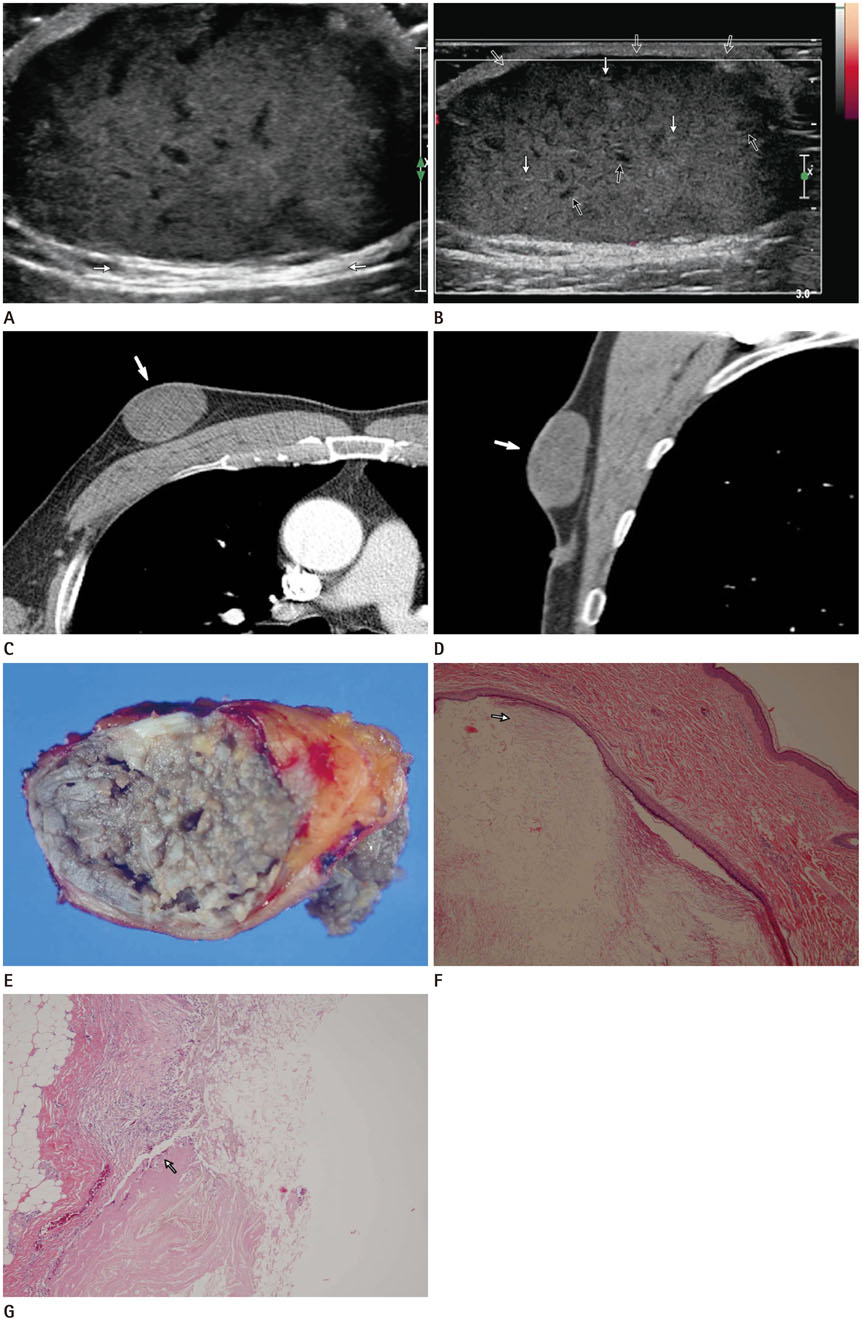J Korean Soc Radiol.
2017 Mar;76(3):206-210. 10.3348/jksr.2017.76.3.206.
Giant Epidermal Inclusion Cyst in the Male Breast: A Case Report
- Affiliations
-
- 1Department of Radiology, Daejin Medical Center Bundang Jesaeng General Hospital, Seongnam, Korea. woonju@dmc.or.kr
- 2Department of General Surgery, Daejin Medical Center Bundang Jesaeng General Hospital, Seongnam, Korea.
- 3Department of Pathology, Daejin Medical Center Bundang Jesaeng General Hospital, Seongnam, Korea.
- KMID: 2371687
- DOI: http://doi.org/10.3348/jksr.2017.76.3.206
Abstract
- Giant epidermal inclusion cyst is a rare disease entity, and the occurrence of this cyst in the male breast is extremely rare. We report a case of giant epidermal inclusion cyst in the breast, which presented as a palpable and painful right breast mass in a 63-year-old man. The sonographic and computed tomography (CT) features are described in-depth. Physical examination revealed a firm, well-defined mass in the upper central portion of the right breast. Ultrasonography showed a 5.2 cm sized, oval, circumscribed, and complex cystic and solid mass with posterior acoustic enhancement, and CT showed a well-defined homogeneous low density mass without enhancement in the right breast. Surgical excision was performed, and pathological examination revealed a giant epidermal inclusion cyst.
MeSH Terms
Figure
Reference
-
1. Ziadi S, Trimeche M, Hammedi F, Sriha B, Jomaa W, Mokni M, et al. Squamous cell carcinoma arising from an epidermal inclusion cyst: a case report. N Am J Med Sci. 2010; 2:46–47.2. Motabar AR. Epidermal inclusion cysts of the breast. Med J Islam Repub Iran. 2009; 22:207–211.3. Mote DG, Shukla AA. Epidermal inclusion cyst masquerading breast lump. Indian J Surg. 2011; 73:458–459.4. Rahul K, Panda A, Handa N, Hari S. Epidermal inclusion cyst in a male breast: parallel linear echoes (tram-track appearance) on sonography as a diagnostic clue. BMJ Case Rep. 2015; 12. 07. [Epub]. DOI: 10.1136/bcr-2015-213045.5. D'Orsi CJ, Sickles EA, Mendelson EB, Morris EA. ACR BIRADS Atlas®, breast imaging reporting and data system. 5th ed. Reston, VA: American College of Radiology;2013.6. Im JT, Park BY. Giant epidermal cyst on posterior scalp. Arch Plast Surg. 2013; 40:280–282.7. Lee YA, Park SG. Giant sized epidermal inclusion cyst of the breast initially mimicking a large fibroadenoma or phyllodes tumor. J Korean Surg Soc. 2012; 83:107–110.8. Kang EJ, Lee JH, Kim EK, Park Y, Jung JS, Kown H, et al. Epidermal inclusion cyst after breast reconstruction with TRAM flaps. J Korean Soc Radiol. 2010; 63:79–82.9. Huang CC, Ko SF, Huang HY, Ng SH, Lee TY, Lee YW, et al. Epidermal cysts in the superficial soft tissue: sonographic features with an emphasis on the pseudotestis pattern. J Ultrasound Med. 2011; 30:11–17.10. Yitta S, Singer CI, Toth HB, Mercado CL. Image presentation. Sonographic appearances of benign and malignant male breast disease with mammographic and pathologic correlation. J Ultrasound Med. 2010; 29:931–947.
- Full Text Links
- Actions
-
Cited
- CITED
-
- Close
- Share
- Similar articles
-
- Giant sized epidermal inclusion cyst of the breast initially mimicking a large fibroadenoma or phyllodes tumor
- A Ruptured Epidermal Inclusion Cyst in the Breast Presenting as a Recurrent Abscess
- Epidermal Inclusion Cyst after Breast Reconstruction with TRAM Flaps
- A Case of Digital Myxoid Cyst Coexisting with Epidermal Inclusion Cyst
- Giant Epidermal Cyst - A Case Repot -


